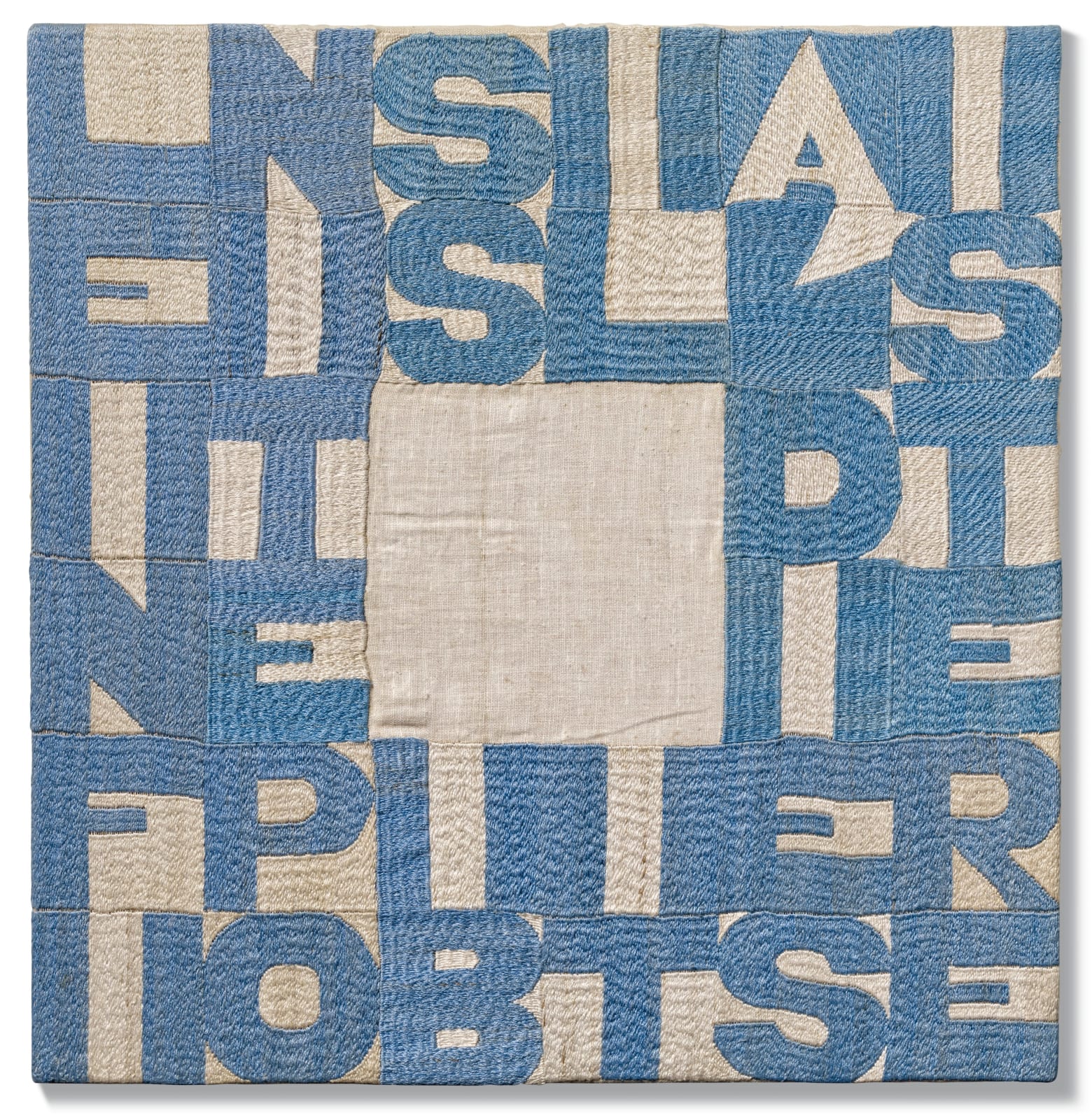
Alighiero Boetti Italian, 1940-1994
Le Infinite Possibilità di Esistere, 1990
Embroidery
34.5 x 33.5 cm; (13 5/8 x 13 1/4 in.)
Copyright The Artist
Further images
Alighiero Boetti’s Arazzi are embroidered word grids that encode poetic phrases and idioms within seemingly abstract fields of letters. Boetti’s research into language was influenced by Persian and Arabic Middle...
Alighiero Boetti’s Arazzi are embroidered word grids that encode poetic phrases and idioms within seemingly abstract fields of letters. Boetti’s research into language was influenced by Persian and Arabic Middle Eastern thought, and through this series he sought to disrupt the conformism of communication. In the Arazzi, Boetti revitalises the symbolic and visual power of the written word, exploring its generative and inherently unstable potential.
The conceptual foundations of the Arazzi trace back to several formative influences in Boetti’s life. After her divorce, Boetti’s mother supported herself by organising a workshop where women embroidered bridal trousseaus. This early exposure to collective, decorative labour later informed Boetti’s approach to the Mappe and other works, in which a uniform template was transformed through embroidery into endlessly unique variations. Boetti’s travels to Afghanistan in 1971 introduced him to the region’s deep-rooted embroidery practices. Afghanistan was not only a site of production for Boetti, but the crucible in which his most significant ideas about labour, authorship, language, and philosophy were inspired and tested. This encounter led to a lasting creative partnership in which Boetti conceived the works, while Afghan women – later displaced by the Soviet invasion in 1979 and working in Peshawar, Pakistan – executed them using the intricate bokhara stitch.
The Arazzi are comprised of letters arranged within geometric grids, forming words that reveal aphorisms, witticisms, or philosophical musings when read vertically. The playful yet cerebral nature of these works exemplifies Boetti’s fascination with language, presenting it as both an intellectual tool and a visual phenomenon. Fragmented into their constituent letters, the words dissolve into shapes and patterns, rendering language simultaneously abstract and systematic. This deliberate fragmentation underscores Boetti’s exploration of language as a constructed, almost arbitrary system – its beauty lying in its capacity for both order and chaos.
Recurring phrases within the Arazzi – including “Ordine e Disordine” (Order and Disorder), “Segno e Disegno” (Sign and Design), and “Mettere al Mondo il Mondo” (Bringing the World into the World) – stand as encapsulations of Boetti’s artistic philosophy. These phrases highlight the artist’s preoccupation with dualities and infinite possibilities, serving as meditative reflections on the human condition and the structures that shape our understanding of the world.
The conceptual foundations of the Arazzi trace back to several formative influences in Boetti’s life. After her divorce, Boetti’s mother supported herself by organising a workshop where women embroidered bridal trousseaus. This early exposure to collective, decorative labour later informed Boetti’s approach to the Mappe and other works, in which a uniform template was transformed through embroidery into endlessly unique variations. Boetti’s travels to Afghanistan in 1971 introduced him to the region’s deep-rooted embroidery practices. Afghanistan was not only a site of production for Boetti, but the crucible in which his most significant ideas about labour, authorship, language, and philosophy were inspired and tested. This encounter led to a lasting creative partnership in which Boetti conceived the works, while Afghan women – later displaced by the Soviet invasion in 1979 and working in Peshawar, Pakistan – executed them using the intricate bokhara stitch.
The Arazzi are comprised of letters arranged within geometric grids, forming words that reveal aphorisms, witticisms, or philosophical musings when read vertically. The playful yet cerebral nature of these works exemplifies Boetti’s fascination with language, presenting it as both an intellectual tool and a visual phenomenon. Fragmented into their constituent letters, the words dissolve into shapes and patterns, rendering language simultaneously abstract and systematic. This deliberate fragmentation underscores Boetti’s exploration of language as a constructed, almost arbitrary system – its beauty lying in its capacity for both order and chaos.
Recurring phrases within the Arazzi – including “Ordine e Disordine” (Order and Disorder), “Segno e Disegno” (Sign and Design), and “Mettere al Mondo il Mondo” (Bringing the World into the World) – stand as encapsulations of Boetti’s artistic philosophy. These phrases highlight the artist’s preoccupation with dualities and infinite possibilities, serving as meditative reflections on the human condition and the structures that shape our understanding of the world.
